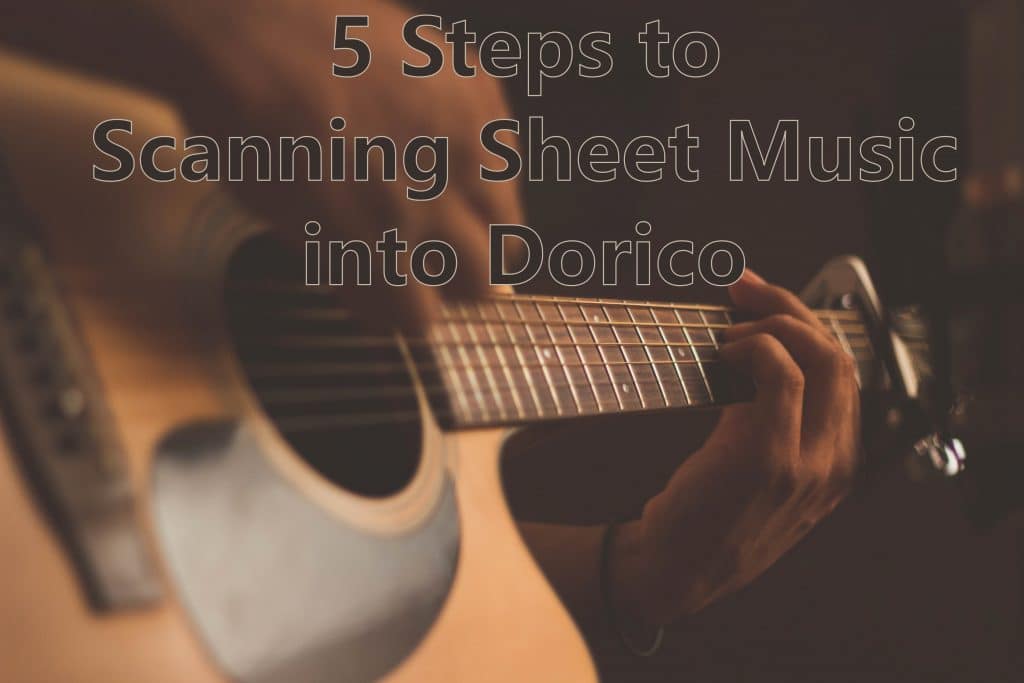Scanning physical sheet music into Dorico can be quick and easy…But only if you have the help of ScanScore! In this post, we will show you all the ins and outs of getting your sheet music digitized and imported into Dorico Software. But first, a little history:
How Dorico Came to Be
While there’s by means no shortage of music editing software, some musicians feel that there has been a serious lack of imagination in the field as a whole. This is one of the many reasons why the company Steinberg developed its own competitive scoring software. It was finally released in 2016. and thus we have Dorico.
Dorico is a score writer for both Windows and Mac. Dorico 3.5 is the most recent iteration of the program. It works really well with ScanScore because ScanScore is also compatible with Windows and Mac. Convenient, huh? Let’s learn just a bit more about Dorico before we get started on the how-to.
Named after the Renaissance composer who pioneered the sheet music printing process, Dorico calls itself “The Future of Scoring.” Dorico aims to provide easy tools, high-quality playback, and excellent customization for today’s modern composers.
That’s all great! But when it comes to scanning existing sheet music, Dorico could sure use some help. And this is where ScanScore’s easy and accurate scanning tools come into play. Dorico and ScanScore are meant to be together! How cute. So let’s see how it’s done:
Step By Step Scanning Instructions
In this section, we’ll detail the steps to follow for scanning sheet music into Dorico. Once you get used to the process, you’ll find it’s really fast and simple!
1) Download/Update Dorico and ScanScore
The first step is downloading Dorico and ScanScore (check out the links below). Even if you already have them downloaded, it’s a good idea to make sure everything is up to date. Be responsible with your technology, folks!
As mentioned earlier, Dorico is available for both Windows and Mac computers, and so is ScanScore You can also access our free app on the Google Play Store, as well as at the App Store for Apple devices. Remember, the app is free, but the software is not. But we promise it’s all worth it!
Side Note: The app is free to download, but it does require a QR code to use it. This QR code is found on your desktop version of ScanScore. This is a safety measure to prevent theft of the software and to keep the price of ScanScore down for authorized users. If you need any additional help pairing your devices, don’t hesitate to reach out to our support team!
2) Scan the Sheet Music

Once you’ve downloaded the programs on your devices, it’s time to scan your sheet music!
Open your ScanScore program, and you’ll see three buttons to help you scan in your music (simply choose the option you want to use):
- Scanner
- Import from file
- Scan with the app
Here’s what the buttons look like:

Scanner refers to using an actual scanner to get the image directly into the program. The Importing Image/ PDF files option takes an image or PDF of sheet music you’ve already got somewhere else and digitizes it into the program. Scanning with the app takes a photo on your phone and sends it directly into ScanScore’s desktop program.
Which should you use? Well, it depends on what you have available. I’ve found the Import from Scanner option to provide the best quality scan with the fewest mistakes. On the other hand, I also have found a lot of great PDFs online at IMSLP, so sometimes I like to use the second button, Import Image/ PDF files. That all being said, Import From App is the most convenient modern option. It all depends on your preferences in equipment.
Pro-tip: When using the app, try to make sure the sheet music is well-lit and that the picture is taken straight-on. A clear image will give you the best results.
3) Correct Any Mistakes
After you choose and implement your digitizing method, your image scan then pops up into ScanScore’s computer program. You will see a side-by-side view of the original and the digital versions of the page. The left is the original, and the right is the scanned version. This will help you make an accurate comparison, and see where any mistakes have occurred in the digitizing process. In addition to all of this, ScanScore picks up potential errors and highlights them in purple and blue.
So how do we edit the music in ScanScore?
ScanScore has a lot of editing capabilities, especially considering the fact that its main function is to digitize music. While these tips that I give you are specific, be sure to remember that we post weekly blog articles with new editing tips in each post. Here’s the editing basics:
To correct errors, zoom in and drag a box over the area where the digital copy is incorrect. Then, use the intuitive toolbar to change, add or delete musical elements as needed. One of ScanScore’s handy features is the side-by-side, synced-zoom functionality. When you select either the original or the digital versions to zoom in on, the other follows suit automatically. This makes it simple to get a close-up view of each version and make a comparison.
In this section, I will give you another editing tip, which is a bit more specific. Here’s how to add a missing clef to your music:
- Locate the upper right side of the editing toolbar
- Select the bass clef “Clef” icon. It will turn blue
- Look to the left of the screen. You will now see all the clefs you need!
- To add a missing clef to the music, select the one you need, and then click where you’d like to put it, on the right-side document
- Congrats! You have now added a missing clef to your music. Take a look below to see what the toolbars look like:

Want to do a final once-over before importing Dorico? I have more good news! ScanScore has a MIDI playback feature. This allows you to playback and track the music you have written, in just a few clicks. And, even better yet, both versions will track at the same time. This function is so useful as a final proofing of the part.
Pro-tip: Saving your file regularly will help protect against accidentally losing any of your progress. You can do this by clicking the “Save as” option under “File.”
4) Export the Music to an XML File
Now your digitized version matches the original. But it still needs to be exported to an XML file in order for Dorico to be able to read it. Here’s how:
In order to export, simply go to the left-hand side of the ScanScore dashboard. There you’ll see the export button. Click “export” and select where to save the file. We recommend you save it in a folder or a place with your other XML files. This should make it easier to find later.
Pro-tip: Choose an easy-to-remember name for your file. Here at ScanScore, we favor the format “piece_composer_part.” Here’s how that might look in practice: “Sonata_Poulenc_Flute.”
5) Import into Dorico
Now it’s finally time to import the file into Dorico. Double-check to make sure that you have the newest version downloaded to make sure it works at optimal efficiency.
Open up your Dorico program. In the main hub, select “Open Other…” and then select your labeled MusicXML file.
After a couple of seconds, the file should show up in Dorico’s program. Congratulations, your score has been successfully scanned into Dorico!
For more help, check out this video about using ScanScore.
And if you need any further support, please contact us at ScanScore Support.
Conclusion
Here’s a quick review of how to scan sheet music into Dorico using ScanScore:
- Download/update the programs
- Scan the sheet music
- Correct mistakes
- Export to MusicXML file
- Import to Dorico
And remember, if you have any questions, please go to ScanScore Support. Have fun making music, and come back to the ScanScore blog soon!
Music quote: “Music is … A higher revelation than all Wisdom & Philosophy”
― Ludwig van Beethoven



Will you be coming out with a ScanScore player for Ipad any time soon?
Pingback: Importing a PDF into Dorico? It's Simple with ScanScore | SCANSCORE